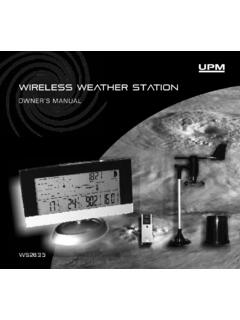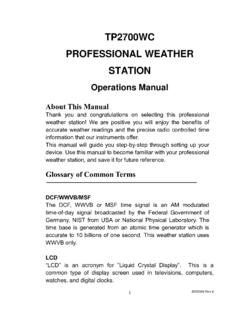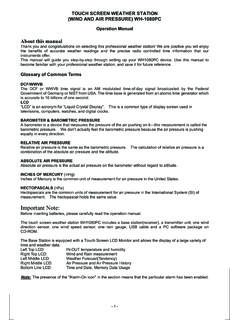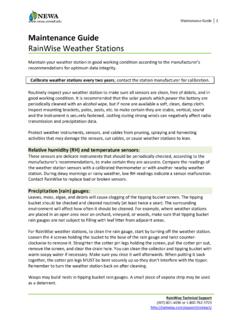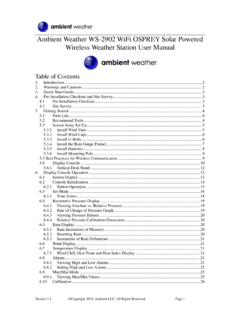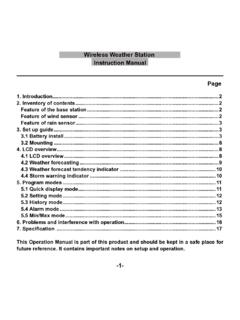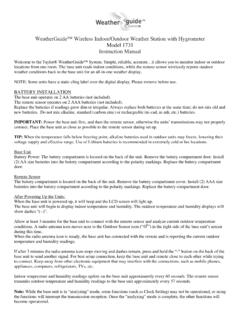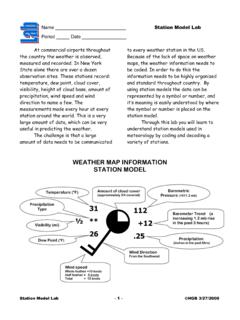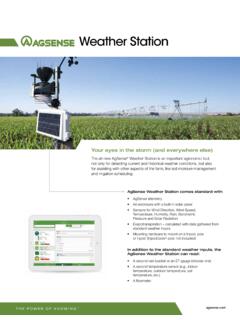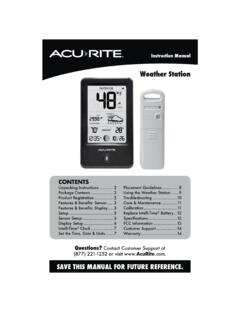Transcription of Weather Station Set Up 101 - Scioto County Storm Chaser …
1 Weather Station Set Up 101 Weather Instrument Location Advice Home Weather Stations are both rewarding and informative and Weather Station setup is fun and easy. However, to obtain accurate Weather information, Weather instrument location should be carefully considered since their placement is directly related to the Weather measurements being taken. Setting up Weather Sensors A Weather Station Installation Overview Setting up home Weather stations is fun, relatively easy, and when completed, rewarding and informative as well. To obtain the most reliable and accurate Weather information, it's important to give some thoughtful consideration as to where the various components are located. Though some compromise may be required, following these general guidelines should enable you to place your Weather sensors in locations that will result in accurate and useful readings.
2 Ideally, Weather sensors should be sited out in the open and away from objects that may affect measurement accuracy. Depending on your situation, features such as landscaping and/or building structures can significantly impact the location where your sensors can be sited. Of course cable length (cabled Weather stations) or transmitter range (wireless Weather stations) will also limit the locations available for placing Weather sensors. A major factor affecting placement of wireless Weather sensors is their transmission range, the maximum distance between the console receiver and remote transmitting sensor. Manufacturers base this rating upon open air ; meaning a line of sight path with no obstructions (walls, etc.) between components. Of course the signal will have to penetrate building materials in most installations, so to estimate the maximum effective ; range between those components the rule of thumb is 1/3 to 1/2 of the open air rating.
3 As an example, if a system has an open air transmission range of 330 feet, the estimated maximum effective range is 110 to 150 feet between outdoor sensor and indoor console. The optimum placement for each type of sensor is different. Thermometers and hygrometers should be installed from four to six feet above the ground in a shaded location (not under trees!). If the thermometer hygrometer is placed on a building, select a location below the eaves on a north facing wall, which will provide shade and some shelter from rain. Rain gauges should be sited out in the open and relatively close to the ground (two feet above is optimal), then leveled. This placement makes it convenient to clean the rain gauge should it become obstructed by debris. Anemometers should be sited in a location where the wind flows freely (such as roof mount) and oriented to true north as instructed by the manufacturer.
4 The standard height of an anemometer is 10 meters (33 feet) above ground. Given the difference in siting recommendations between anemometers and rain gauges, mounting them together should be avoided. The indoor console should be located where it's convenient to see and use it. Barometers are typically housed in the console and some consideration should be given to that barometer when determining console placement. Linking to a computer or other equipment will likely narrow those options. For the installation of wireless Weather stations, it's a good idea to put it near an outside wall and as close as possible to the remote sensors. Remember that radio signal strength will be reduced by each layer of building material the signals must penetrate. Be extremely careful when installing your Weather stations components and follow all procedures recommended by the manufacturer.
5 Use caution and common sense, Safety First! When installing a mast for anemometers, keep in mind the danger of falling or coming into contact with power lines. Be aware too that any elevated metal pole can act like a lightning rod so be sure to ground it properly. Failure to do so could prove to be deadly. Rain Gage Siting a Rain Sensor Simply put, rain gages are used to record the cumulative precipitation at a given location for a given time. There are a variety of factors that can affect rain gage measurements. Buildings, landscaping and trees, and even the wind can impact the amount of precipitation reaching the rain detector. Proper placement is critical to ensure that rain sensor readings are an accurate representation of the actual rain measurement rates and amounts that have fallen.
6 The ideal site for a rain gage is in an open area that is protected from the wind in all directions, such as in a large inner court yard, an unlikely possibility for most owners of Weather stations. Therefore, rain gages should be sited in an open area away from the external factors mentioned above. A good guideline to follow as a minimum distance from these objects is twice their height. This may be difficult in some situations, so the best compromise is to stay as far away as possible from the objects and ideally no closer than half their height. Wireless rain gauges are often the best choice for difficult installation locations. Rain gages should also be sited relatively close to the ground but not so close that precipitation falling next to the rain detector splashes into it.
7 The minimum guideline is no lower than two feet. However, the issue with height isn't limited to the rain gage being too close to the ground. The rain sensor can also be sited too high. This was demonstrated over two centuries ago (1769) when a rain gage was placed atop a 30 foot tall house and it received only 80% of the amount that ground-based rains gauge measured. Another rain sensor was placed on top of a 150 foot church tower and it only received 50% of the ground level rain detector measurement! It wasn't until the late 1800s that researchers learned why. Wind was the culprit! What then is the best rain gage height? Actually the minimum guideline of two feet is best and no higher than six feet. Finally, to ensure optimal performance, rain gages must be mounted on a vibration-free level surface.
8 Use a bubble level to make sure that the surface is indeed level. This is critical to the accuracy of the most common type of rain detector sensor, the tipping bucket rain gauge which degrades significantly if installed on a non-level plane. Thermometer Hygrometer Siting an Outdoor Thermometer & Hygrometer Taking accurate temperature and humidity measurements is not as easy as you may think. Factors associated with solar radiation and other sources of heating and cooling can cause erroneous readings if your thermometer and/or digital hygrometers are not sited properly. Temperature humidity sensors, often combined into one instrument on home Weather stations (thermometer hygrometer), should not be sited in direct sunlight unless they are adequately protected by a solar radiation shield or placed inside a ventilated Weather measurement tools housing.
9 If that is not an option, the thermometer hygrometer sensors should be installed in a shaded location (such as the north side of a structure) and protected from rainfall (under the eaves but not too close to the roof is a compromise). Ideally thermometer hygrometer Weather sensors should be located in an open area and on level terrain - preferably above trimmed grass, which will allow for ventilation and air mixing between the sensor and ground. Avoid soil/dirt, natural groundcover, and rough or rocky terrain unless representative of your area. Steep slopes should be avoided also, as water and/or air flow induced by gravity could produce non-representative data. The standard height above ground for a thermometer hygrometer is five feet ( meters). If at all possible, keep the thermometer hygrometer away local sources of heating and cooling, and from nearby obstructions by a distance of at least four times their height.
10 Be at least 100 feet (30 meters) from large areas of concrete and/or asphalt. Avoid sites where water or snow collects. DO NOT install the sensors under the shade of trees or vegetation. Anemometer Installing Wind Speed Sensor The goal of installing a wind speed meter (anemometer) is to position it in a location where the wind flows freely and is not influenced by nearby objects. The World Meteorological Organization has set the international standard height for wind measurement devices at 10 meters (33 feet) above ground, with no obstructions at or above this level. Attaining this height can not only be difficult but expensive as well. For most home Weather stations installations, striking a compromise is likely the best alternative. So what are your alternatives? Part of the answer to that is how accurate you want your measurements to be?
